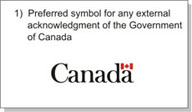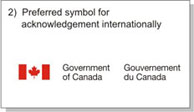Top areas of interest for federal identity
On this page
- Federal Identity Program requirements when partnering with an external organization
- Visual acknowledgement for a Government of Canada contribution or partnering arrangement
- Endorsements
- Creating or changing applied titles and abbreviations
- Ordering or updating a sign for a building
Federal Identity Program requirements when partnering with an external organization
Collaborative arrangements with other levels of government and the private sector comply with Policy on Communications and Federal Identity requirements. In brief, this means that departments are responsible for ensuring that the Government of Canada receives fair and visible acknowledgement for its contributions of public funds and that all partners are fairly acknowledged in partnering and collaborative arrangements.
Treasury Board submissions pertaining to such activities must assure ministers that the government program or activity complies with Policy on Communications and Federal Identity requirements and that the government contribution will be clearly visible in all communications with the public.
The terms and conditions of agreements must provide for the visual acknowledgement of the Government of Canada. The following standard clause contains all of the required visual acknowledgement elements for such agreements:
[The recipient] shall, in all public communications (including but not limited to websites, publications, news releases, presentations, reports, advertising, paid announcements, expositions and project signage), acknowledge the financial contribution of the Government of Canada.
[The recipient] shall consent to a form of acknowledgement that has been approved by the Minister or his/her representatives and that may include text and official government symbol(s). [The recipient] shall consent to limit the acknowledgement to applications agreed upon and remove the acknowledgement upon the request of the Minister or his/her representatives.
[The recipient] shall cease acknowledging the Government of Canada, including all uses of official government symbols, upon the expiration of this agreement, unless otherwise specified.
It is the department's responsibility to provide the approved form of acknowledgement and to ensure it is used according to the terms of the agreement. The department's Federal Identity Program coordinator or communications branch should be consulted to ensure the correct graphic files are provided.
Visual acknowledgement for contributions or partnering arrangements
Despite the fact that every department has two official symbols (a signature and the Canada wordmark), federal institutions observe the general principle of "one logo per partner" when providing an approved copy of an official symbol for inclusion in a funding recipient's public communications or as part of a joint initiative with other partners.
Choice of symbol
As figures 1 to 3 illustrate, there are three general options for presenting a visual acknowledgement. The Canada wordmark is the preferred option since it can be displayed larger than either the signature of the Government of Canada or of a department. The wordmark is also highly recognized by the Canadian public as a symbol of the Government of Canada.
Because multiple signatures cannot be used in the same application, for visual acknowledgement of two or more federal institutions, either the Canada wordmark or the Government of Canada signature is used. For international applications, the Government of Canada signature is the preferred option.



Displaying a government symbol with other identifiers
There is no rule regarding the order of identifiers in a multi-party acknowledgement; however, the government symbol is typically displayed first or last. When the size of the federal contribution warrants a more prominent acknowledgement than the other partners, the attributes of size and position should be negotiated to ensure its prominence. In these instances, a department may negotiate the use of both a signature and the Canada wordmark.
Composing a text credit
Text credits should be brief and to the point. As illustrated in Figure 4, there is no rule for the inclusion of a text credit; however, a text credit is recommended when the government is the sole contributor or where the symbol would otherwise be displayed by itself. Communications or official languages advisors should be consulted about the language requirements and wording of the text credit, if necessary.

Endorsements
For the purposes of the Federal Identity Program, an endorsement is defined as the inference, expression or declaration of a preference, sanction, or favour for any private sector enterprise, organization, activity or product. An endorsement or what could be perceived by the public as an endorsement may be created, either by a department or an individual, through written text, public statements, or the use of names, logos and proprietary imagery.
Endorsements are commonplace in the private sector because they have commercial value and can provide a competitive advantage. For the Government of Canada, however, providing an advantage to one interest is unfair to all others. It directly conflicts with requirements in the Policy on Communications and Federal Identity and the Values and Ethics Code for the Public Sector and its principle of treating all members of the public with fairness, impartiality and objectivity. Unchecked, the practice can undermine public confidence in the sound administration of federal institutions.
An endorsement should not be confused with the fair, objective and equitable acknowledgement of sponsors, partners and institutions participating in a joint initiative. Nor should it be confused with providing factual public information or data pertaining to contracts or contractors.
Ordering or updating a sign for a building
The Government of Canada signage system covers virtually every type of sign needed for federal facilities and services. This signage system is key to ensuring that the public can recognize federal facilities and access government services and that both the public and employees are well served with clear directions and warning signs.
One of the responsibilities of facilities management is to ensure that all signs are well maintained and their messages are up to date, accurate and bilingual. While Public Services and Procurement Canada is the largest custodian of federal office space, there are many departments and contractors with custodial responsibilities for structures and spaces owned or occupied by the government.
To ensure quality manufacturing, durability and consistent application of the mandatory government standards, a National Master Standing Offer for Government Signage has been in place for more than a decade. The services provided through the standing offer are available in all regions of the country and include site assessments, design and layout, manufacturing, shipping and installation. Standard signs are kept in stock, whereas signs with variable messaging require time to design and manufacture. Signage services also include decals for motor vehicles and specialty signs that are created in consultation with the Federal Identity Program.
The standing offer is managed by Public Services and Procurement Canada. All institutions are strongly encouraged to make use of this service to ensure the quality, consistency and durability of government signage as well as its compliance with policy. Public Service and Procurement Canada provides advice on and support in using the standing offer. Enquiries may be directed to Public Service and Procurement Canada by email: TPSGC.Enseignes-Signage.PWGSC@tpsgc-pwgsc.gc.ca.